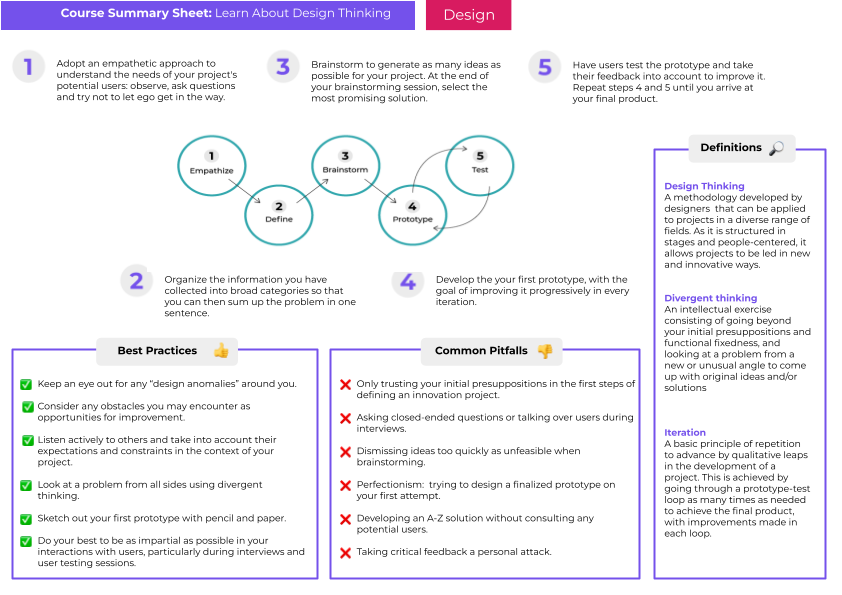Design thinking can be a great way to grow in your professional activity, even if you think you’re "far" from the design or digital sphere.
Justify the Merits of This Approach With Your Collaborators
The design thinking method may seem exciting at first, but an innovator who “goes rogue” and steps outside of workplace norms is not always seen in a very positive light.
What if nobody around me has heard of design thinking?
But don't worry: the purpose of this course is also to help you avoid this!
If you’ve enjoyed this course or it sparked something in you, you can pass on that enthusiasm and find people who are willing to try the method out with you.
Start by finding people in your workplace who are naturally positive, dynamic, and considerate, so you can:
discuss your project in the early stages and see how they would be interested in participating.
or discuss projects that you could develop together, i.e., multi-disciplinary/transversal projects.
What do I do if I'm told I don't have the time or the budget?
Unfortunately, this is an old classic that you might hear from your colleagues or manager(s). It’s the type of resistance you’ll typically encounter in the first step (empathy), which is often considered too time-consuming and unpredictable.
If this is the case, the people you’re facing need "proof" that what you are doing is valuable. The rest of this chapter will help you to provide this!
Document Your Innovation Process
You’ve gained a lot of experience working on your project, and step by step, you’ve been able to test the design thinking method.
Keep a record of everything you have done!
During Step 1: Empathy
You should keep:
the field notes you took during the observation phase.
a copy of the interview guide.
the responses gathered from different interviews,
and the user profiles (or personas).
During Step 2: Definition
Go back to:
your notes and tests of the 5 Whys technique.
your final design challenge.
During Step 3: Brainstorming
Remember to keep:
Post-it notes used during the brainstorming session and possibly photos of the session.
the online board of a tool like Miro.
During Step 4: Prototype
Gather together the photos or screenshots of all the phases your prototype has gone through:
The initial sketches, drawings, diagrams.
The latest and most successful versions.
During Step 5: Test
Gather:
feedback collected during the various test sessions.
tables that list feedback categorized by what to keep, improve or remove.
potential evaluation grids completed by the participants.
You now have more than enough to work with!
Present the Results of Your Project
The documentation work you have done throughout your project will allow you to gain perspective on the progress you’ve made.
But before you fire up your computer, outline the following on a sheet of scrap paper:
Write a bit about your original idea, the one that started it all.
Sketch out the before and after of your project.
Illustrate the journey in images, with people on your team or those who helped you.
Jot down some quotes and testimonials collected throughout the project.
Recount any funny anecdotes, moments of discouragement, and/or intense excitement or failures you encountered.
What’s the point of doing all this?
This will help you construct the story of your project and to think about your storytelling so that you’re prepared to:
give a presentation to any stakeholders.
pitch your concept at a start-up competition.
talk about your product at a conference.
generate support for your concept.

Share the Impact of Your Product or Service
You have reached the end of your project, you have documented it throughout and kept any and all stakeholders involved. You will have plenty of material because you have a clear vision of all the phases you went through:
Personal achievements.
Things that didn’t go as planned.
Obstacles you encountered.
Now you can share your new product or service with a broader audience!
But why?
This will allow you to:
formally showcase the impact of the project you worked on.
communicate the lessons you learned that everyone can benefit from.
You can then share the impact of your project with people who were not involved in the development but who may be interested.
Why include them if they didn’t participate?
Because you can:
generate support for the design thinking approach.
show how it works using your example.
This might make them want to try it, and you will have planted a seed.
To help you develop the message you want to put out to a wider audience, ask yourself the following questions:
What do I want to see happen with this product or service?
How could I get more time or budget to work on it further?
What would I like to hear from others about my product/service?
How will I measure the success of my product or service over time? Using what criteria? Qualitative? Quantitative?
Take your time in answering these questions—this will allow you to establish indicators to measure the results of your product or service launch.
Continue the Learning Process
Congratulations!
The course is coming to an end: I hope you enjoyed it and that it has sparked a desire to develop your own innovation projects!
Now you know how to use the design thinking method in your projects.
Let’s Recap!
To manage a project using an innovative method like design thinking, it is a good idea to surround yourself with other people rather than working alone to avoid the risk of challenges justifying your project further down the road.
Identifying naturally dynamic or optimistic people is the first step to finding help with your project or even future collaborators.
Documenting your project’s progress allows you to keep track of what was done during each phase. This will be extremely valuable when creating a presentation and/or sharing your results.
The more you share what you do with others, the more likely you are to generate support around an innovation process, get support from others, and get others around you on board with the project you are developing in particular.
Download the Course Summary

You have reached the end of the course, and now you can test your knowledge of this last part. Good luck! 😉
